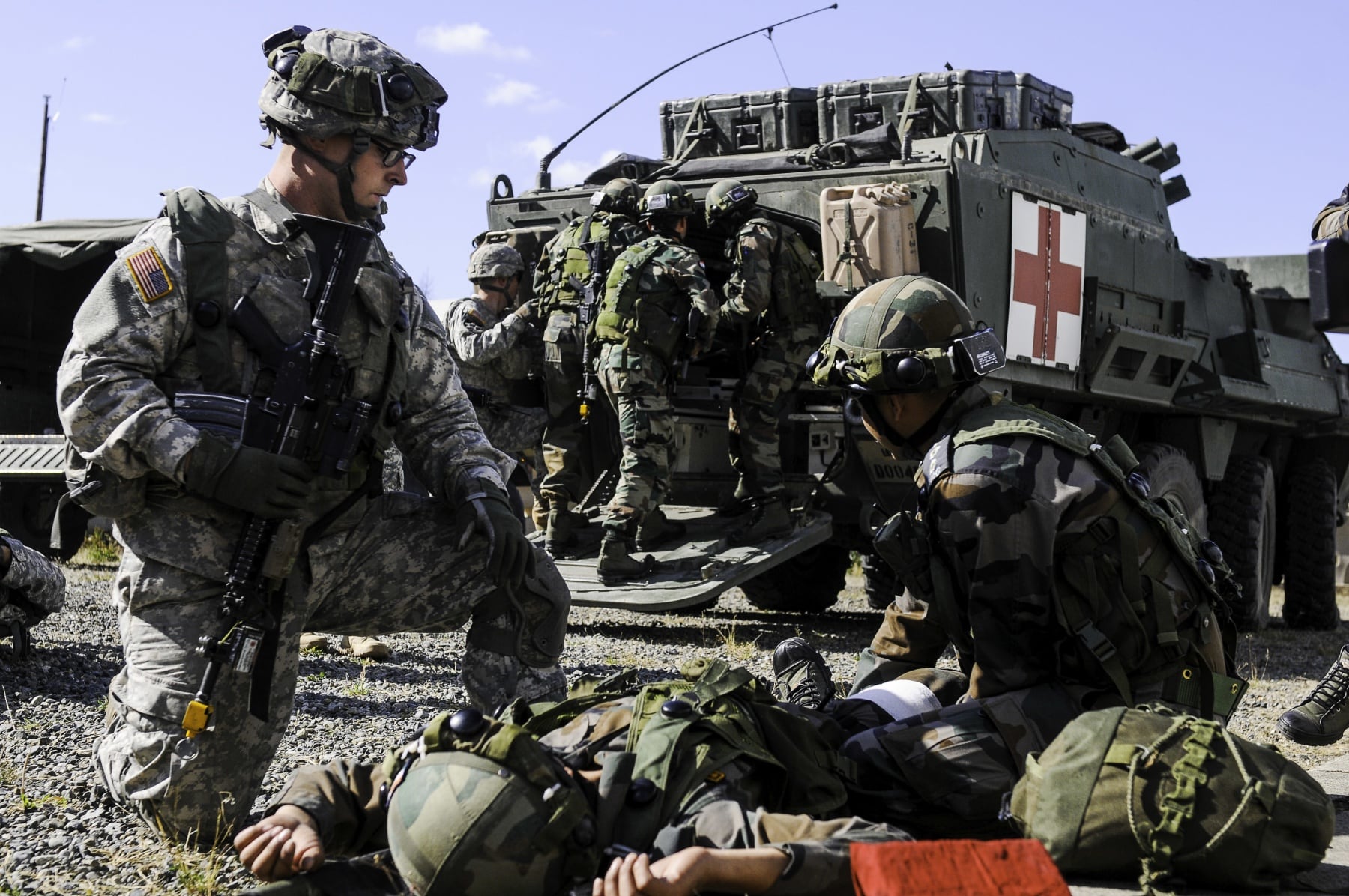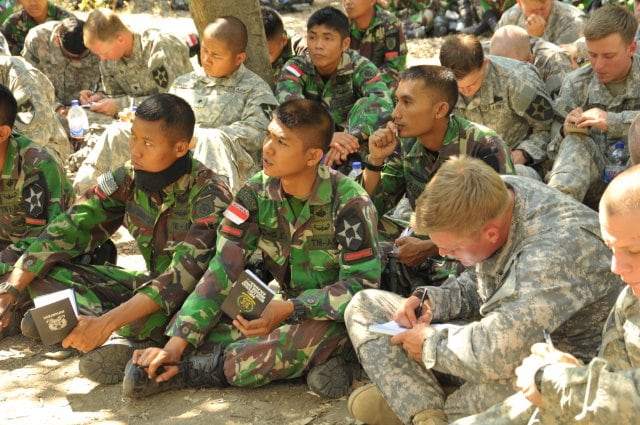"Any time you have something that's good like this, you want to see how you can enable it," Lt. Gen. Stephen Lanza, commanding general of I Corps, said in an interview with Army Times. "One of the great things about how you build readiness is you want to continue to look at how you continue to adjust conditions, how you add complexity to the training."
Pacific Pathways made its debut in 2014 when more than 800 soldiers from the 2nd Stryker Brigade Combat Team, 2nd Infantry Division, of Joint Base Lewis-McChord, Washington, spent three months in Asia.
The Pathways concept employs a single unit through what officials call a "training pathway." This unit spends three to four months in a series of already approved, consecutive bilateral and multilateral exercises and engagements with foreign militaries.
Pathways are part of the Army's contribution to the United States' rebalance to the Asia-Pacific Region. They also line up with the Army's regionally aligned forces concept, which aims to commit troops to a specific region of the world to support the geographic combatant commanders.
The Army ran three Pathways in fiscal year 2015, with stops in Mongolia, Japan, South Korea, Thailand, the Philippines, Malaysia, Australia and Indonesia.
At least two Pathways are scheduled for fiscal 2016, with more on the books for 2017, Lanza said.
"Pathways builds and sustains readiness because it's treated as an operational deployment," he said. "So when you deploy into Pathways, you have to do everything back at home station that you would normally do for a deployment."
This includes preparing soldiers' families and standing up support teams in the rear, he said. Because these exercises are like "little mini deployments," they allow the force to exercise its communications systems and ability to sustain itself across long distances.
"It's really morphed into a deployment, an operation, and it has added value to the readiness that we want to build across the force," Lanza said. "It's been really, really helpful to our organization, and what we've done here is take a bunch of disparate exercises and actually link them together into an operation."

Indian soldiers from 6th Battalion, 6th Kumaon Regiment attend to wounded soldiers and civilians before loading them on a medical Stryker combat vehicle while conducting company movement procedures with 1st Brigade, 2nd Infantry Division during exercise Yudh Abhyas at Joint Base Lewis-McChord, Wash., on Sept. 21.
Photo Credit: Sgt. Daniel Schroeder/Army
The Pathways have not only enhanced the readiness of participating units, it has improved the Army's relationships with several partner nations in the region, he said.
"In addition to helping us, there's this twinning concept where capability is built and readiness is built, as well as relationships with our partners," Lanza said. "This is very promising. It will start to morph here and develop. There's opportunity now to expand this with the total force, perhaps some joint enablers, perhaps a multifunctional brigade … as we look at different opportunities across the Pacific."
The Army assesses every Pacific Pathways rotation in search of ways to improve the program, Lanza said.
"From the first one we did, things have improved along the way, everything from preparing soldiers to deploy, the training that is done, [to] the live-fire training that's being done," he said. "Everything has been modified and changed, and that's what you want to do. We build on it."
As it plans future Pacific Pathways, the Army will now look at ways to incorporate more Army Reserve or National Guard soldiers into the training.
"I think the big issue for them is to make sure the requirements are given to them early enough so they can plan for it in their training cycle," Lanza said, adding his soldiers at Joint Base Lewis-McChord often train with reserve component troops.
"Right now, in all our training, whether it's at the National Training Center, Joint Readiness Training Center, Pacific Pathways, our operational missions for Yama Sakura, Ulchi Freedom Guardian or Talisman Sabre, we've had Guard and Reserve with us along the way," Lanza said.
The Guard and Reserve played a critical role alongside the active Army in Iraq and Afghanistan, and that partnership must continue, Lanza said.
"They've been so important in Afghanistan and Iraq," he said. "We want to sustain that."
The Army also must work through how it can use the Guard and Reserve as part of a Pacific Pathway rotation, which is three to four months long. Issues to figure out include whether the soldiers are mobilized, how they should be mobilized and how much it might cost, Lanza said.

Soldiers from TNI 411 Raider Infantry Battalion and the U.S. 2nd Battalion, 1st Infantry Regiment listen to how to properly execute an ambush mission as part of Exercise Garuda Shield at Puslatpur Training Base, Indonesia, on Sept. 3.
Photo Credit: Army
Apart from Pacific Pathways, I Corps remains busy in the Pacific, Lanza said.
The corps headquarters just completed Talisman Sabre in Australia, Ulchi Freedom Guardian in South Korea, and participated in the recent Network Integration Evaluation at Fort Bliss, Texas.
I Corps will host China's People's Liberation Army in November for a disaster management exercise and is preparing for Yama Sakura in Japan in December. In January, it will serve as higher headquarters in a warfighter exercise with the 3rd and 4th Infantry Divisions, and later in the year will participate in a second warfighter exercise, this time with the XVIII Airborne Corps.
Two of its brigade combat teams are preparing for rotations at the combat training centers, and the next Pacific Pathway kicks off in May.
"Operationally, we're as busy as we've ever been," Lanza said. "Our op tempo in the corps is extremely busy. But my concern isn't the op tempo. My concern is the resourcing of that. We can do the training. We can meet the requirements. The concern will be in the future, as the resources become less, can we resource what we need to be doing to sustain our readiness with what we've been asked to do? That will be the challenge."
As soldiers fan out across the Pacific, they "love" the new experiences and training opportunities they're receiving, Lanza said.
"You have to manage the op tempo, but soldiers are doing what they love to do," he said. "They're getting to go out and train, they're getting to go to different countries, you get to have these tremendous experiences."
America's partners in Asia also welcome the presence of U.S. soldiers, Lanza said.
"They want us to stay engaged, they want us to train with their organizations," he said. "The kind of training that we're doing with these countries really helps avoid miscalculation and deescalate conflict, and that's what you want in the Pacific theater. You don't want to have a mistake in the Pacific theater."
The Army's ability to engage with its Pacific partners is critical, Lanza said.
"We want to continue to sustain that in the Pacific for as long as we can," he said. "That's why the resources to do these kinds of operations are so important. Every country I've been in, when you talk to the militaries there, they want this consistent, habitual relationship with the U.S. military."
Michelle Tan is the editor of Army Times and Air Force Times. She has covered the military for Military Times since 2005, and has embedded with U.S. troops in Iraq, Afghanistan, Kuwait, Haiti, Gabon and the Horn of Africa.



